mississippi river

 Many factors go into the “make or break” status of a town. Sometimes, it’s all about location. Other times, it’s about what is built after the town is formed. Still other times, it’s about what is discovered there and how low its supply lasts. The town of Doaksville, Oklahoma was once the largest town in the Choctaw Nation. Doaksville was founded in the early 1820s when Josiah S Doaks and his brother established a trading post. It was a humble beginning that sprang from the anticipation of the arrival of the Choctaw Indians to the area after the signing of the Treaty of Doak’s Stand in October 1820. The brothers moved westward with their boats filled with goods for the trading post and headed up the Mississippi and Red Rivers. Soon, other settlers moved into the area to be close to the store for mutual protection.
Many factors go into the “make or break” status of a town. Sometimes, it’s all about location. Other times, it’s about what is built after the town is formed. Still other times, it’s about what is discovered there and how low its supply lasts. The town of Doaksville, Oklahoma was once the largest town in the Choctaw Nation. Doaksville was founded in the early 1820s when Josiah S Doaks and his brother established a trading post. It was a humble beginning that sprang from the anticipation of the arrival of the Choctaw Indians to the area after the signing of the Treaty of Doak’s Stand in October 1820. The brothers moved westward with their boats filled with goods for the trading post and headed up the Mississippi and Red Rivers. Soon, other settlers moved into the area to be close to the store for mutual protection.
There were raids from the Plains Indians, especially those from Texas, which necessitated the establishment in 1824, of nearby Fort Towson. With the establishment of the fort, Doaksville began to grow and had all the makings of becoming a permanent town. Roads were built, between Doaksville, the trading post, and Fort Towson to establish a supply line. Doaksville sat at the center of these crossroads, and Doaksville began to prosper from the Central National Road of Texas that ran from Dallas to the Red River before connecting with the Fort Towson Road, which went on to Fort Gibson and beyond to Fort Smith, Arkansas. Doaksville seemed to be right in the thick of things. In addition, steamboats on the Red River connected with New Orleans at a public landing just a few miles south of Doaksville, carrying supplies to Fort Towson and agriculture products out of the region. It looked like Doaksville was headed for greatness.
Then, in 1837, the Choctaw and the Chickasaw signed the Treaty of Doaksville, which allowed the Chickasaw to lease the westernmost portion of the Choctaw Nation for settlement. By 1840, Doaksville was really growing. It now sported five large merchandise stores, two of which were owned by Choctaw Indians and the others by licensed white traders. There was a harness and saddle shop, wagon yard, blacksmith shop, gristmill, hotel, council house, and church. A newspaper called the Choctaw Intelligencer…printed in both English and Choctaw.
Of course, with the settlement came the missionaries. A missionary named Alvin Goode described the settlement at the time, “The trading establishment of Josiah Doak and Vinson Brown Timms, an Irishman, had the contract to supply the Indians their rations, figured at 13 cents a ration. A motley crowd always assembled 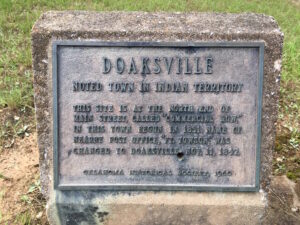 at Doaksville on annuity days to receive them. Some thousands of Indians were scattered over a nearly square mile tract around the pay house. There were cabins, tents, booths, stores, shanties, wagons, carts, campfires; white, red, black and mixed in every imaginable shade and proportion and dressed in every conceivable variety of style, from tasty American clothes to the wild costumes of the Indians; buying, selling, swapping, betting, shooting, strutting, talking, laughing, fiddling, eating, drinking, smoking, sleeping, seeing and being seen, all bundled together.”
at Doaksville on annuity days to receive them. Some thousands of Indians were scattered over a nearly square mile tract around the pay house. There were cabins, tents, booths, stores, shanties, wagons, carts, campfires; white, red, black and mixed in every imaginable shade and proportion and dressed in every conceivable variety of style, from tasty American clothes to the wild costumes of the Indians; buying, selling, swapping, betting, shooting, strutting, talking, laughing, fiddling, eating, drinking, smoking, sleeping, seeing and being seen, all bundled together.”
The town of Doaksville continued to grow, and in 1847 a post office was established. By 1850, the town had grown to more than thirty buildings, including stores, a jail, a school, a hotel, and two newspapers. Now established, it became the capital of the Choctaw Nation. For the next several years, Doaksville continued to thrive. Then, in 1854 Fort Towson was abandoned, and that spelled disaster for Doaksville. Without the business from the soldiers at the fort, Doaksville began to decline. Nevertheless, it would remain the tribal capital for the next nine years.
The Civil War, which broke out in 1861, spelled disaster for Doaksville. The region’s plantation-based economy was hit especially hard. In 1863, the Choctaw capital was moved to Chahta Tamaha, where it would remain until 1882, when it was moved for a third and final time to Tuskahoma, Oklahoma. The largest force in the Indian Territory was commanded by Confederate Brigadier General Stand Watie, chief of the Cherokee Nation. He was not one to admit defeat, and he would become the last Confederate general to surrender his command. When the leaders of the Confederate Indians learned that the government in Richmond, Virginia, had fallen and the Eastern armies had surrendered, most began making plans for surrender. The chiefs convened the Grand Council on June 15, 1865, and passed resolutions calling for Indian commanders to lay down their arms. Brigadier General Stand Watie refused until June 23, 1865, 75 days after Lee’s surrender in the East. At that point, he finally accepted the futility of continued resistance. He surrendered his battalion of Creek, Seminole, Cherokee, and Osage Indians to Lieutenant Colonel Asa C Matthews at Doaksville.
The collapse of the southern economy based on slave labor basically signed the death warrant Doaksville, and with the construction of the Saint Louis and San Francisco Railroad through the Southern Choctaw Nation in 1900-1901, its fate was sealed. At that time, the few buildings that remained at Doaksville were abandoned or moved to a new town that formed near the railroad, taking the name of the old post…Fort Towson. In 1903, the name of the Doaksville post office was changed to Fort Towson.
In 1960, the old town of Doaksville was acquired by the Oklahoma Historical Society. Little remained on the surface to betray its former importance, but in the 1990s, several archaeological excavations occurred, exposing the foundations of several buildings, including a jail, wells, a store, a hotel, and thousands of artifacts. 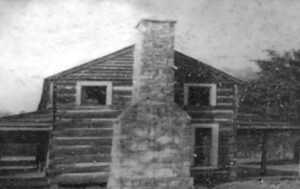
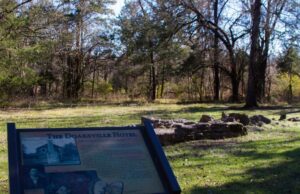 Today, a walking trail leads visitors through the site with interpretive signs telling the history of the old settlement. The old townsite has been designated as a National Historic Site, can be accessed through the Fort Towson Cemetery. A portion of the cemetery holds the burial sites of many important people who lived and died in Doaksville.
Today, a walking trail leads visitors through the site with interpretive signs telling the history of the old settlement. The old townsite has been designated as a National Historic Site, can be accessed through the Fort Towson Cemetery. A portion of the cemetery holds the burial sites of many important people who lived and died in Doaksville.
 There are certain things which really should never be mixed together. One of the biggest is alcohol and the operation of any vehicle. That fact was made perfectly clear on May 8, 1837, when the steamship, Ben Sherrod was headed down the Mississippi River. The American side-wheel steamer Ben Sherrod, weighing 393 tons, was under the command of Captain Castleman, and was en route from New Orleans to Louisville carrying about 200 passengers, general freight, a large quantity of coins consigned to banks in Tennessee, and a considerable amount of wealth belonging to private individuals. As was not uncommon, the Ben Sherrod was engaged in an exciting race with the steamer Prairie. It was one o’clock in the morning, and the boat was about fourteen miles from Fort Adams, pushing her way up the Mississippi with as much speed as she could muster. Still, the Ben Sherrod was in sight of, but lagging behind the Prairie. The crew of the Ben Sherrod were determined, if possible, to pass the Prairie by, so the firemen were shoving in the pine knots, and sprinkling rosin over the coal…basically doing their best to raise more steam.
There are certain things which really should never be mixed together. One of the biggest is alcohol and the operation of any vehicle. That fact was made perfectly clear on May 8, 1837, when the steamship, Ben Sherrod was headed down the Mississippi River. The American side-wheel steamer Ben Sherrod, weighing 393 tons, was under the command of Captain Castleman, and was en route from New Orleans to Louisville carrying about 200 passengers, general freight, a large quantity of coins consigned to banks in Tennessee, and a considerable amount of wealth belonging to private individuals. As was not uncommon, the Ben Sherrod was engaged in an exciting race with the steamer Prairie. It was one o’clock in the morning, and the boat was about fourteen miles from Fort Adams, pushing her way up the Mississippi with as much speed as she could muster. Still, the Ben Sherrod was in sight of, but lagging behind the Prairie. The crew of the Ben Sherrod were determined, if possible, to pass the Prairie by, so the firemen were shoving in the pine knots, and sprinkling rosin over the coal…basically doing their best to raise more steam.
In addition to the necessary supplies needed to operate the steamship, they also had a barrel of whisky set before them, and they were drinking from it heavily and often, until they were very drunk. As they continued to load the boilers to dangerous levels, the boilers became so hot that the sixty cords of wood on board burst into flames. The Ben Sherrod was soon completely enveloped in flames, and to make matters worse, the drunken men ran away from their posts, rather than doing whatever they could to put out the fire and get the passengers to safety. The approximately 200 passengers were sound asleep, completely oblivious to the terror that awaited them.
When the deck hands discovered the fire, they too left their posts and ran for the yawl (a type of boat that can be used with sails or oars…basically a lifeboat), without warning the passengers. Captain Castleman tried to dispel the panic and confusion, by telling them the fire was extinguished. He tried to keep them from lowering of the yawl, which was what they were attempting. Then, the screams of nearly three hundred and fifty persons on board could be heard. The panic was obvious and could be heard for several miles. They were yelling, “To the shore! To the shore!” The boat made for the starboard shore, but could not reach as the wheel ropes soon burned. When they decided to let off the pent-up steam, the boat kept on up the river. The scene was simply horrific. The yawl, which had been filled with the crew, had sunk, drowning nearly all who were in it. That left the passengers with no choice but to jump from the burning ship, without even taking time to dress. There were ten ladies who all went silently overboard. Some drowned instantly, and others clung to planks. In the end, only two of the ladies were saved. While drowning was horrific enough, worse yet was the fact that several passengers were burned alive.
When the steamer, Colombus arrived on scene 30 minutes later, they found a man named Ray, from Louisville, Kentucky, clinging to a rope at the bow of the boat, where he had jumped to in an effort to escape the heat and flames. Ray’s face and arms were terribly burned while clinging to the boat, but he had to hang on and endure the agony. He lost twenty thousand dollars in coins, but he saved his life, so I’m sure the money was of little consequence to him. The steamboat Alton arrived half an hour after the Columbus, but it carelessly came in too fast, causing the drowning of many people who were floating in the water. As Alton came in, the people were too weak to get out of the way. To make matters worse, it was dark, and they were probably difficult to see in the water. A gentleman by the name of Hamilton, from Limestone County, Alabama, was floating on a barrel, with one of the ladies, when the Alton came up, washing them both under. The lady drowned, but Hamilton came up and floated down the river fifteen miles. Finally, he was rescued by the steamer Statesman. A man named McDowell stayed afloat for some time, fighting against the current, and floated only two miles down the river, finally reaching the shore, but his wife, who was floating on a plank, was drowned when the steamer Alton came rushing in. In all only two ladies out of ten who were on board were saved…one of these was the captain’s wife and the other was Mrs Smith, of New Orleans. Of the 300 people on board, it was later estimated that only 70 had escaped with their lives. The loss of Ben Sherrod was complete negligence, and that only because I can’t think of something worse to call it right now.
Many people were furious with the captain of the Prairie, for leaving a boat in flames without turning around to give aid to the victims. Another man, this one in a canoe near the scene of the disaster refused to save any who were floating in the water, unless they promised to pay him handsomely for his services…scum, if you ask me. The Ben Sherrod disaster was one of the worst calamities that ever occurred on the Mississippi river. During the burning of the Ben Sherrod eight different explosions occurred; first, barrels of whiskey, brandy, and then the boilers blew up with a huge explosion. Finally, forty barrels of gunpowder exploded. That explosion could be heard for miles. The wreckage blew apart, scattering fragments in all directions. Immediately after that 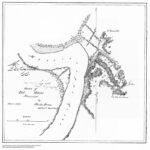 explosion, the wreck sunk out of sight just above Fort Adams, taking with it a large quantity of coins, which was on its way to the Tennessee Banks.
explosion, the wreck sunk out of sight just above Fort Adams, taking with it a large quantity of coins, which was on its way to the Tennessee Banks.
The ship remained in the river for years, but now, the remains of the Ben Sherrod are currently being recovered by a consortium of private investors. The remains of the steamship are lying upside down about one mile from Fort Adams and a little over a mile from the present channel of the Mississippi River. The ship has been buried under approximately seventy feet of sand and mud, possibly making it hard to find. So far, about 50 feet of hull timbers have been uncovered. They were in surprisingly excellent condition and the group is hoping that the cargo is there (especially all those coins), still intact, and as well preserved.
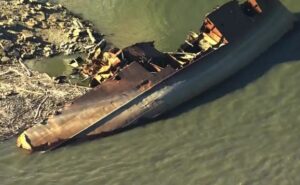
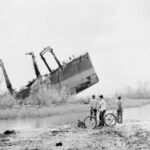 Some years are filled with rainy and snowy days, while others are drought filled, like this one. Each can have their consequences, if things go too far. As drought in the United States has progressed this past year, lakes and rivers have dried up, including the widest river…the great Mississippi River, which is not nearly as wide or as deep as it used to be. The reality is that suddenly, the Mississippi is bone-dry in some places. The average depth of the Mississippi River is normally 9 to 12 feet, with the deepest point being 200 feet. As with any river that is deep enough to run big boats or even little ones, invariably, there comes a sinking or two.
Some years are filled with rainy and snowy days, while others are drought filled, like this one. Each can have their consequences, if things go too far. As drought in the United States has progressed this past year, lakes and rivers have dried up, including the widest river…the great Mississippi River, which is not nearly as wide or as deep as it used to be. The reality is that suddenly, the Mississippi is bone-dry in some places. The average depth of the Mississippi River is normally 9 to 12 feet, with the deepest point being 200 feet. As with any river that is deep enough to run big boats or even little ones, invariably, there comes a sinking or two.
Sometimes, boats that sink can be recovered, and sometimes they can’t. The ship might be at a depth that makes it impossible, or the right equipment might not be available. Whatever the reason, in just about any body of water, there are bound to be a few mysterious finds hiding beneath the surface. As the Mississippi River has gone through the drought this year, there are the expected myriad of boats that are now stranded and languishing on dry land, but there are also a few surprises that are starting to appear. Some of the ships are old, but some are not as old, like the Diamond Lady, a casino boat that used to grace the mighty river. The Diamond Lady was christened in 1991, and was used in Iowa for a time, but in 2019, as things in Iowa got tough, the beautiful casino boat sailed south to an unknown fate in the mighty Mississippi River. The boat had been stored in Lake McKellar, but sank in 2021 during a freeze. Now it has resurfaced again. It’s not the oldest relic in the Mississippi River and the surrounding waterways, but it might have been the most majestic.
Unfortunately, there are sad finds in the river too. The drought has unearthed a sunken 19th-century shipwreck and human remains in the Mississippi River. I’m sure these won’t be the only human remains that suddenly surface, because while drowning victims are often found, there comes with a gambling a certain element that 
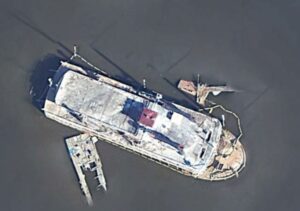 often brings the mysterious deaths, whether they are murders or just mysterious deaths whose cause cannot be determined. I’m sure there will be more ship, and possibly more bodies that turn up too. Then, before too long, the waters will return, and the mysteries will once again be hidden beneath the surface of the rivers and lakes.
often brings the mysterious deaths, whether they are murders or just mysterious deaths whose cause cannot be determined. I’m sure there will be more ship, and possibly more bodies that turn up too. Then, before too long, the waters will return, and the mysteries will once again be hidden beneath the surface of the rivers and lakes.
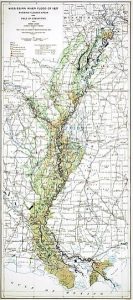 The Mississippi River is a is the widest river in the United States. It’s mere size and the amount of water in it, makes one expect that at some point, it is going to flood. In fact, it has flooded many times over the years, but none was anything like the Great Mississippi Flood of 1927. It was the most destructive river flood in the history of the United States. In all, 27,000 square miles of land were inundated with water up to a 30 feet depth. In all, 630,000 people were affected by the flood. About 94% of them lived in the states of Arkansas, Mississippi, and Louisiana, most in the Mississippi Delta. At least 15 inches of rain fell in 18 hours causing the Mississippi River to brake out of its levee system at 145 locations. Ten states were affected…Arkansas, Illinois, Kentucky, Louisiana, Mississippi, Missouri, Tennessee, Texas, Oklahoma, and Kansas. Arkansas was the worst affected with 14% of the state flooded.
The Mississippi River is a is the widest river in the United States. It’s mere size and the amount of water in it, makes one expect that at some point, it is going to flood. In fact, it has flooded many times over the years, but none was anything like the Great Mississippi Flood of 1927. It was the most destructive river flood in the history of the United States. In all, 27,000 square miles of land were inundated with water up to a 30 feet depth. In all, 630,000 people were affected by the flood. About 94% of them lived in the states of Arkansas, Mississippi, and Louisiana, most in the Mississippi Delta. At least 15 inches of rain fell in 18 hours causing the Mississippi River to brake out of its levee system at 145 locations. Ten states were affected…Arkansas, Illinois, Kentucky, Louisiana, Mississippi, Missouri, Tennessee, Texas, Oklahoma, and Kansas. Arkansas was the worst affected with 14% of the state flooded.
It was Good Friday, April 15, 1927, the disaster began when 15 inches of rain fell in New Orleans in 18 hours. More than 4 feet of water covered parts of the city. A group of influential bankers in town met to discuss how to guarantee the safety of the city, as they had already learned of the massive scale of flooding upriver. A few weeks after, they arranged to set off about 30 tons of dynamite on the levee at Caernarvon, in an effort to flood a less populated area and save the cities that would have been severely damaged. I’m not sure how much this effort helped, and in the end, about 500 people lost their lives anyway. It wouldn’t be the last Mississippi River flood, but it would be the worst.
As a result of the flooding, many of the misplaced people joined the Great Migration from the south to northern and midwestern industrial cities rather than return to rural agricultural labor. I would think that the idea of such a massive amount of cleanup would be more than many people could take. This massive population movement increased from World War II until 1970. Of course, this volume of population movement would not be good for the states who were losing people. To try to prevent future floods, the federal government built the world’s 
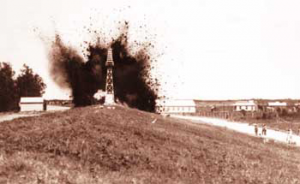 longest system of levees and floodways. By August 1927, when the flood subsided, hundreds of thousands of people had been made homeless and displaced; properties, livestock and crops were destroyed. Flooding on the Mississippi is not an unusual event, and no matter how many precautions we take, there will still be losses when the river overflows its banks.
longest system of levees and floodways. By August 1927, when the flood subsided, hundreds of thousands of people had been made homeless and displaced; properties, livestock and crops were destroyed. Flooding on the Mississippi is not an unusual event, and no matter how many precautions we take, there will still be losses when the river overflows its banks.
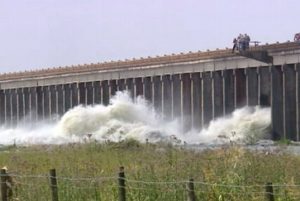
 As a kid, I remember that whenever we were sitting at an intersection that was very busy, causing us to have to wait seemingly forever to be able to get across the intersection, one of my parents would say something like, “Wow!! Who opened the floodgates?” Of course, I didn’t know what a floodgate was then, and I just thought they were referring to a flood of vehicles, which they were, and they probably didn’t think about what a real floodgate was either. It was just a funny saying to us, but in reality, a floodgate is a very important flood preventative tool. I guess that our version of floodgates meant the same thing, except in vehicles and not in water.
As a kid, I remember that whenever we were sitting at an intersection that was very busy, causing us to have to wait seemingly forever to be able to get across the intersection, one of my parents would say something like, “Wow!! Who opened the floodgates?” Of course, I didn’t know what a floodgate was then, and I just thought they were referring to a flood of vehicles, which they were, and they probably didn’t think about what a real floodgate was either. It was just a funny saying to us, but in reality, a floodgate is a very important flood preventative tool. I guess that our version of floodgates meant the same thing, except in vehicles and not in water.
On May 15, 2011, the United States Army Corps of Engineers opened the floodgates in the state of Louisiana along the Mississippi river. This was an effort to save larger cities located along the Mississippi, like Baton Rouge and New Orleans, from flooding. The Mississippi was already heading for critical stages, and it was only expected to get worse. The flooding was expected to cover up to three thousand square miles, and it had the potential to affect up to 25,000 people. This was the first time in forty years that the river levels have forced the opening of the floodgates. I don’t know how often floodgates are utilized in other areas to prevent flooding, but when people live in flood prone areas, they have to use whatever mean necessary to protect themselves and their property from damage and death.
The Mississippi River floods in April and May 2011 were among the largest and most damaging recorded along that river in the past century. The flood was comparable in extent to the major floods of 1927 and 1993. From April 14–16, the storm system that was responsible for one of the largest tornado outbreaks in US history also produced large amounts of rainfall across the southern and midwestern United States. Then two more storm systems, each with heavy rain and tornadoes, hit in the third week of April. In the fourth week of April, from April 25–28, another and even more extensive and deadly storm system passed through the Mississippi Valley dumping more rainfall resulting in deadly flash floods. The unprecedented extensive rainfall from these four storms, combined with springtime snow melt from the Upper Midwest, created the perfect conditions for a 500-year flood along the Mississippi.
The purpose of opening the floodgates was to take some of the pressure off of the levees, in the hope of preventing the breech of the levees. Most of the time, it works pretty well, like when the city of Casper, Wyoming, where I live opens up the gates at the area lakes and while the river runs high for a time, there are 
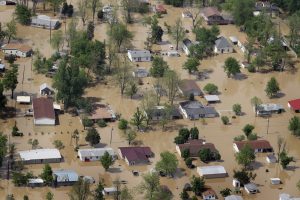 very few places where it spills over the bank. Unfortunately, the Mississippi river still spilled over its banks, and broke levees. I don’t think anyone could have really prevented the monster floods that hit the area in 2011, or even in 1927 or 1933, but they couldn’t focus on that right then, because they had to do whatever they could to prevent. In the end, the flood came and the damage was done.
very few places where it spills over the bank. Unfortunately, the Mississippi river still spilled over its banks, and broke levees. I don’t think anyone could have really prevented the monster floods that hit the area in 2011, or even in 1927 or 1933, but they couldn’t focus on that right then, because they had to do whatever they could to prevent. In the end, the flood came and the damage was done.
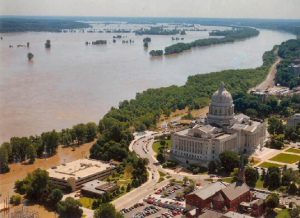 When a river is as wide as the Mississippi, and traveling through so many states, often through flat land, the potential for flooding always exists. I know that many people who live along the Mighty Mississippi, would never consider living anywhere else. They love that old river, and having been there myself, I can certainly understand why. The river views are beautiful. Still, the yearly potential for flooding is something that might put many people off, when it comes to living on the shores of that river. Of course, people can get flood insurance, and indeed, most banks would require it for properties along that river, but the possessions lost in floods, not to mention the time it takes to rebuild the homes, and especially the lives lost in floods, make living on the shores of the Mississippi something that I would probably not decide to do.
When a river is as wide as the Mississippi, and traveling through so many states, often through flat land, the potential for flooding always exists. I know that many people who live along the Mighty Mississippi, would never consider living anywhere else. They love that old river, and having been there myself, I can certainly understand why. The river views are beautiful. Still, the yearly potential for flooding is something that might put many people off, when it comes to living on the shores of that river. Of course, people can get flood insurance, and indeed, most banks would require it for properties along that river, but the possessions lost in floods, not to mention the time it takes to rebuild the homes, and especially the lives lost in floods, make living on the shores of the Mississippi something that I would probably not decide to do.
The Great Mississippi Flood of 1927 was the most destructive river flood in the history of the United States,  with 27,000 square miles inundated up to a depth of 30 feet. To try to prevent future floods, the federal government built the world’s longest system of levees and floodways. Of the more than 630,000 people affected by the flood, 94% lived in the states of Arkansas, Mississippi, and Louisiana, most in the Mississippi Delta. By August 1927, the flood subsided. Hundreds of thousands of people had been made homeless and displaced…properties, livestock and crops were destroyed. Some people left the area, because they did not have the money, or the stomach for living in an area where their homes could so easily be wiped out. Still, the draw of the beautiful Mississippi kept many people there, determined to rebuild their lives. Of course, the flood didn’t only affect the people living along the Mississippi. Lost crops affected many people in the United States. It was a disaster of epic proportions.
with 27,000 square miles inundated up to a depth of 30 feet. To try to prevent future floods, the federal government built the world’s longest system of levees and floodways. Of the more than 630,000 people affected by the flood, 94% lived in the states of Arkansas, Mississippi, and Louisiana, most in the Mississippi Delta. By August 1927, the flood subsided. Hundreds of thousands of people had been made homeless and displaced…properties, livestock and crops were destroyed. Some people left the area, because they did not have the money, or the stomach for living in an area where their homes could so easily be wiped out. Still, the draw of the beautiful Mississippi kept many people there, determined to rebuild their lives. Of course, the flood didn’t only affect the people living along the Mississippi. Lost crops affected many people in the United States. It was a disaster of epic proportions.
Then came the floods of the Mississippi and Missouri rivers in 1993, also known as the Great Flood of 1993. This is one that many of us alive today remember, mostly because we were old enough to remember, but also because the television and newspapers were filled with the stories of destruction. The flood was among the most costly and devastating to ever occur in the United States, with $15 billion in damages. The damage area  was more than 745 miles in length and 435 miles in width, totaling about 320,000 square miles. Within this zone, the flooded area totaled around 30,000 square miles and was the worst such US disaster since the Great Mississippi Flood of 1927, as far as duration, area flooded, persons displaced, crop and property damage, and number of record river levels. In some ways, the 1993 flood even surpassed the 1927 flood, which was, at the time, the largest flood ever recorded on the Mississippi River. The effects were felt by people all over the United States because of crops lost, the rise in the cost of building materials, and of course, insurance rates as a result of increased building material prices. Floods are nearly impossible to prevent, and for some people they are considered a risk they are willing to take, but for me, I think I’ll stick to places where the chance of a flood hitting my home is almost nil. On October 7, 1993, the Great Flood of 1993 came to an end as the Mississippi River finally started to recede, 103 days after the flooding began.
was more than 745 miles in length and 435 miles in width, totaling about 320,000 square miles. Within this zone, the flooded area totaled around 30,000 square miles and was the worst such US disaster since the Great Mississippi Flood of 1927, as far as duration, area flooded, persons displaced, crop and property damage, and number of record river levels. In some ways, the 1993 flood even surpassed the 1927 flood, which was, at the time, the largest flood ever recorded on the Mississippi River. The effects were felt by people all over the United States because of crops lost, the rise in the cost of building materials, and of course, insurance rates as a result of increased building material prices. Floods are nearly impossible to prevent, and for some people they are considered a risk they are willing to take, but for me, I think I’ll stick to places where the chance of a flood hitting my home is almost nil. On October 7, 1993, the Great Flood of 1993 came to an end as the Mississippi River finally started to recede, 103 days after the flooding began.
 Most people know that with an earthquake underwater, comes the possibility of a tsunami. Tsunamis can cause as much or more damage that the original earthquake. I think we all know that living in a coastal area puts the residents in possible danger when these offshore earthquakes hit, but what happens further inland? The tsunami doesn’t normally travel too far inland…unless it is a fluvial tsunami. This was a type of tsunami I had never heard of before. Nevertheless, on this day, February 7, 1812, there was a series of earthquakes in Missouri. They were the most violent and powerful quakes in the history of the United States. The series of tremors, which took place between December 1811 and March 1812. The Seismic activity was quite unusual for the area around the city of New Madrid, located near the Mississippi River in present day Arkansas, which had about 1,000 residents at the time, most of whom were farmers, hunters, and fur trappers. It all began on December 15, 1811with unusual tremors. Then, at 7:15am, an even more powerful quake erupted, now estimated to have been an 8.6 magnitude quake. This quake literally knocked people off their feet and many people experienced nausea from the extensive rolling of the earth. Given that the area was sparsely populated and there weren’t many multi-story structures, the death toll was relatively low. However, the quake did cause landslides that destroyed several communities, including Little Prairie, Missouri.
Most people know that with an earthquake underwater, comes the possibility of a tsunami. Tsunamis can cause as much or more damage that the original earthquake. I think we all know that living in a coastal area puts the residents in possible danger when these offshore earthquakes hit, but what happens further inland? The tsunami doesn’t normally travel too far inland…unless it is a fluvial tsunami. This was a type of tsunami I had never heard of before. Nevertheless, on this day, February 7, 1812, there was a series of earthquakes in Missouri. They were the most violent and powerful quakes in the history of the United States. The series of tremors, which took place between December 1811 and March 1812. The Seismic activity was quite unusual for the area around the city of New Madrid, located near the Mississippi River in present day Arkansas, which had about 1,000 residents at the time, most of whom were farmers, hunters, and fur trappers. It all began on December 15, 1811with unusual tremors. Then, at 7:15am, an even more powerful quake erupted, now estimated to have been an 8.6 magnitude quake. This quake literally knocked people off their feet and many people experienced nausea from the extensive rolling of the earth. Given that the area was sparsely populated and there weren’t many multi-story structures, the death toll was relatively low. However, the quake did cause landslides that destroyed several communities, including Little Prairie, Missouri.
The quake also caused fissures…some as much as several hundred feet long…to open on the earth’s surface. Large trees were snapped in two. Sulfur leaked out from underground pockets and river banks vanished, flooding thousands of acres of forests. On January 23, 1812, an estimated 8.4-magnitude quake struck in  nearly the same location, causing disastrous effects. Reportedly, the president’s wife, Dolley Madison, was awoken by the quake in Washington, DC. The death toll was smaller for this quake, because most of the survivors of the first earthquake were now living in tents, so they could not be crushed. The strongest of the tremors followed on February 7, 1812, and was estimated at an amazing 8.8 magnitude…probably one of the strongest quakes in human history. Church bells rang thousands of miles away in Boston, Massachusetts, from the shaking. Brick walls were toppled in Cincinnati, Ohio. In the Mississippi River, water turned brown and whirlpools developed suddenly from the depressions created in the riverbed. Waterfalls were created in an instant and in one report, 30 boats were helplessly thrown over falls, killing the people on board. Many of the small islands in the middle of the river, often used as bases by river pirates, permanently disappeared…possibly a poetic end to their crimes. Large lakes, such as Reelfoot Lake in Tennessee and Big Lake at the Arkansas-Missouri border, were created by the earthquake as river water poured into new depressions in the ground. But, probably the most unusual activity, was what happened to the Mississippi River next. Because of the quake’s proximity to the Mississippi River, the quake had an effect that was probably unheard of until that time…a Fluvial Tsunami. A Fluvial Tsunami is something I never knew existed, but apparently it does. The quake and the ensuing fluvial tsunami in the Mississippi River, actually made the river run backward for several hours. I’m sure people were stunned and frightened at what they saw.
nearly the same location, causing disastrous effects. Reportedly, the president’s wife, Dolley Madison, was awoken by the quake in Washington, DC. The death toll was smaller for this quake, because most of the survivors of the first earthquake were now living in tents, so they could not be crushed. The strongest of the tremors followed on February 7, 1812, and was estimated at an amazing 8.8 magnitude…probably one of the strongest quakes in human history. Church bells rang thousands of miles away in Boston, Massachusetts, from the shaking. Brick walls were toppled in Cincinnati, Ohio. In the Mississippi River, water turned brown and whirlpools developed suddenly from the depressions created in the riverbed. Waterfalls were created in an instant and in one report, 30 boats were helplessly thrown over falls, killing the people on board. Many of the small islands in the middle of the river, often used as bases by river pirates, permanently disappeared…possibly a poetic end to their crimes. Large lakes, such as Reelfoot Lake in Tennessee and Big Lake at the Arkansas-Missouri border, were created by the earthquake as river water poured into new depressions in the ground. But, probably the most unusual activity, was what happened to the Mississippi River next. Because of the quake’s proximity to the Mississippi River, the quake had an effect that was probably unheard of until that time…a Fluvial Tsunami. A Fluvial Tsunami is something I never knew existed, but apparently it does. The quake and the ensuing fluvial tsunami in the Mississippi River, actually made the river run backward for several hours. I’m sure people were stunned and frightened at what they saw.
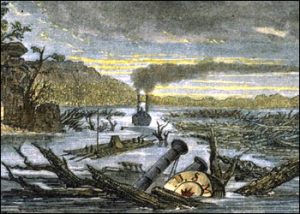
The exact death toll from this series of deadly quakes is difficult to determine because of a lack of an accurate record of the Native American population in the area at the time. The series of quakes ended in March of 1812, with aftershocks continuing for years. In the end, it was decided that approximately 1,000 people died because of the quakes, but it could be much higher. As I researched this crazy tsunami, I found out that fluvial refers to a river tsunami, the Mississippi River has actually flowed backward multiple times, and fluvial tsunamis are actually not that rare, they occur whenever a quake causes the water in a river to flow backward it rush in is normal direction.

